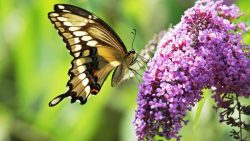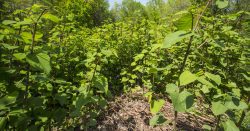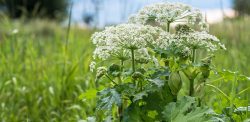Invasive plants in BC may be more popular than you think– in fact, they’re often widely used. But how do you know which plants are considered invasive? And, perhaps more importantly, how do you maintain them?

What does “invasive” mean?
In short, an invasive plant is a plant species that can be harmful when introduced into a new area.
Invasive plants spread through wind, animals, human interference, or on their own. They often out-compete native plants for resources like sun and water, which harms the natural ecosystem. Because invasive plants are, by definition, non-native, a new environment (climate, soil, temperature, sun/shade, etc) might lack the ability to keep its growth in check.
Some invasive plants are well-known and prohibited by local law, such as noxious weeds Japanese knotweed and giant hogweed, both of which can be extremely harmful when allowed to proliferate. However, there are some types of invasive plants that are not only legal – they’re actually quite popular. You might even have some in your own garden.

Japanese knotweed

Giant hogweed
5 Common Invasive Plants in BC
If you’re looking to add some new plants to your garden, you might want to re-think adding any of the following popular plants, all of which the ISC (Invasive Species Council of BC) considers invasive. If you do decide to install any of these plants, do so at your own risk and be prepared to spend a little extra time on garden maintenance!
1. Butterfly Bush (Buddleja davidii)
Butterfly bush is an appealing, semi-evergreen plant that is known for attracting butterflies. It grows up to 15 feet tall and has pink or purple spike-shaped bunches of small flowers. Though it’s considered a very beautiful plant, it produces thousands of seeds, which are easily spready by wind and water and grow quickly, making this ornamental shrub highly invasive.

2. English Ivy (Hedera helix)
Despite being common as a groundcover or ornamental climber, English ivy grows quickly and can cling to virtually any surface – including other plants. Its growth is also very dense, meaning it can quickly suppress native plants if left unchecked. Identifiable by its dark green, waxy leaves, ivy can be an effective and attractive groundcover, but it needs regular pruning to keep it from damaging walls, buildings, trees, and other plants.

3. Periwinkle (Vinca minor)
Featuring small, dark green leaves and delicate purple flowers in the spring, periwinkle’s appeal as a spilling ornamental groundcover climber is widely evident. However, it spreads via seeds and roots and grows very densely, choking out other plants when left untrimmed. Despite this, periwinkle is one of the most popular invasive plants still sold in BC.

4. Foxglove (Digitalis purpurea)
With attractive, tubelike flowers growing in vertical spires, foxglove has a broad appeal for those who want a natural-looking, pollinator-friendly garden. However, they produce thousands of seeds and spread with ease, which can be a huge detriment to your landscape. Foxgloves are also very toxic if ingested.

5. Holly (Ilex aquifolium)
That’s right — despite its universal popularity for use in holiday decorations, holly is actually considered invasive! Known for its bright red berries and deep green, sharp leaves, it can grow extremely tall (up to 30 feet), and can thrive easily in both sun and shade. Its seeds are usually spread by birds who ingest holly berries.

What Next?
Do you have any of these plants on your property and never realized they were invasive? We may be able give you a hand with pruning and maintenance! Get in touch for a consultation!

Comments are closed here.